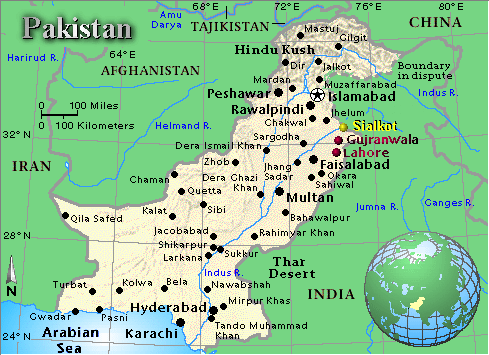
| PAKISTAN | Quaid-I-Azam Mohammad Ali Jinnah | WORLD NEWSPAPERS | PAKISTAN'S COOKING | HOME REMEDIES | PAKISTAN EMBASSIES | ART OF MEHNDHI | STATUS CHECKER & LOVE METER |
|
|
 |
|
|


|
|
 |
|
    The National Anthem of Pakistan
|
|
 |
Location: Southern Asia, bordering the Arabian Sea, between India
on the east and Iran and Afghanistan on the west and China in the north
Geographic coordinates: 30 00 N, 70 00 E
Map references: Asia
Area: Areacomparative: slightly less than twice the size of California
Land boundaries: Coastline: 1,046 km
Maritime claims: Climate: mostly hot, dry desert; temperate in northwest; arctic in
north
Terrain: flat Indus plain in east; mountains in north and northwest;
Balochistan plateau in west
Elevation extremes: Natural resources: land, extensive natural gas reserves, limited petroleum,
poor quality coal, iron ore, copper, salt, limestone
Land use: Irrigated land: 171,100 sq km (1993 est.)
Natural hazards: frequent earthquakes, occasionally severe especially
in north and west; flooding along the Indus after heavy rains (July and August)
Environmentcurrent issues: water pollution from raw sewage, industrial
wastes, and agricultural runoff; limited natural fresh water resources; a majority of the population does not have access
to potable water; deforestation; soil erosion; desertification
Environmentinternational agreements: Geographynote: controls Khyber Pass and Bolan Pass, traditional invasion
routes between Central Asia and the Indian Subcontinent
total: 803,940 sq km
land: 778,720 sq
km
water: 25,220 sq km
total: 6,774 km
border countries:
Afghanistan 2,430 km, China 523 km, India 2,912 km, Iran 909 km
contiguous zone: 24 nm
continental
shelf: 200 nm or to the edge of the continental margin
exclusive economic zone: 200 nm
territorial sea:
12 nm
lowest point: Indian Ocean 0 m
highest
point: K2 (Mt. Godwin-Austen) 8,611 m
arable land: 27%
permanent crops:
1%
permanent pastures: 6%
forests and woodland: 5%
other: 61% (1993 est.)
party to: Biodiversity,
Climate Change, Desertification, Endangered Species, Environmental Modification, Hazardous Wastes, Law of the Sea, Nuclear
Test Ban, Ozone Layer Protection, Ship Pollution, Wetlands
signed, but not ratified: Marine Life Conservation
| People |
Population: 138,123,359 (July 1999 est.)
Age structure:
0-14 years: 41% (male 29,423,876; female
27,763,774)
15-64 years: 55% (male 38,533,918; female 36,804,592)
65 years and over: 4% (male 2,768,942;
female 2,828,257) (1999 est.)
Population growth rate: 2.18% (1999 est.)
Birth rate: 33.51 births/1,000 population (1999 est.)
Death rate: 10.45 deaths/1,000 population (1999 est.)
Net migration rate: -1.3 migrant(s)/1,000 population (1999 est.)
Sex ratio:
at birth: 1.05 male(s)/female
under 15
years: 1.06 male(s)/female
15-64 years: 1.05 male(s)/female
65 years and over: 0.98 male(s)/female
total population: 1.05 male(s)/female (1999 est.)
Infant mortality rate: 91.86 deaths/1,000 live births (1999 est.)
Life expectancy at birth:
total population: 59.38 years
male: 58.49 years
female: 60.3 years (1999 est.)
Total fertility rate: 4.73 children born/woman (1999 est.)
Nationality:
noun: Pakistani(s)
adjective: Pakistani
Ethnic groups: Punjabi, Sindhi, Pashtun (Pathan), Baloch, Muhajir (immigrants from India and their descendants)
Religions: Muslim 97% (Sunni 77%, Shi'a 20%), Christian, Hindu, and other 3%
Languages: Punjabi 48%, Sindhi 12%, Siraiki (a Punjabi variant) 10%, Pashtu 8%, Urdu (official) 8%, Balochi 3%, Hindko 2%, Brahui 1%, English (official and lingua franca of Pakistani elite and most government ministries), Burushaski, and other 8%
Literacy:
definition: age 15 and over can read and write
total population: 37.8%
male: 50%
female: 24.4% (1995 est.)
| Government |
Country name:
conventional long form: Islamic Republic
of Pakistan
conventional short form: Pakistan
former: West Pakistan
Government type: federal republic
Capital: Islamabad
Administrative divisions: 4 provinces, 1 territory*, and 1 capital
territory**; Balochistan, Federally Administered Tribal Areas*, Islamabad Capital Territory**, North-West Frontier, Punjab,
Sindh
note: the Pakistani-administered portion of the disputed Jammu and Kashmir region includes Azad Kashmir and
the Northern Areas
Independence: 14 August 1947 (from UK)
| Military |
Military branches: Army, Navy, Air Force, Civil Armed Forces, National Guard
Military manpowermilitary age: 17 years of age
Military manpoweravailability:
males age 15-49: 33,496,712 (1999 est.)
Military manpowerfit for military
service:
males age 15-49: 20,519,762 (1999 est.)
Military manpowerreaching military
age annually:
males: 1,553,310 (1999 est.)
Military expendituresdollar figure: $2.48 billion (FY98/99)
Military expenditurespercent of GDP: 4.4% (FY98/99)
Video Clip
REAL PLAYER G2
or above required
Tum Hee Sey Aey Mujahido (Alamgir)
Don't forget to sign.
| Sign our Guestbook |
 |
View our Guestbook |
| Search The Internet |
